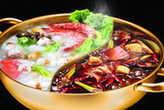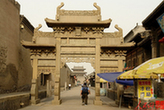He returned to China in 1927 and subsequently gained a number of important posts, including dean of the Fine Arts Department of the Nanguo Art Academy in Shanghai, professor at the Fine Arts Department of the Central University, and president of the National Art School of Beiping. From 1933 Xu successively organized exhibitions of Chinese art and his own works in France, Belgium, Italy, the U.K., Germany and the Soviet Union, and in 1950 he became president of the Central Academy of Fine Arts. The Xu Beihong Arts Award established in 2003, fifty years after his death, is considered the highest award in the field of Chinese calligraphy and painting.
For Xu, painting was a process of continual study. He believed in the importance of good technique, which could always be improved, and learning from past masters. He also saw the value of drawing from Western techniques, excelling both in oil painting and traditional Chinese ink painting, as well as in drawing. His paintings show diverse artistic styles and combine techniques from both traditions.
Xu created paintings covering a wide range of forms, including landscapes, portraits, and images from history and legends. The flowers, birds, landscape and animals produced under his brush are valued for being life-like and vivid. He is widely recognized for his paintings of horses, which demonstrate his unique style that fused Chinese and Western painting techniques.
In recent years Xu’s works have fetched higher and higher prices under the hammer. At the end of last year, his painting titled Jiu Zhou Wu Shi Le Geng Yun (The Ploughing Season of China ), which portrays farmers tilling their land with an ox, was sold for RMB 266.8 million, or about US $40.02 million, smashing previous records for his paintings at auction. Many of his paintings fetched over RMB 10 million. Those that have fetched over RMB 100 million include Ba People Fetching Water , Chun Shan Shi Jun Tu , which portrays 10 horses, and Jiufanggao, (The Connoisseur of Horses ).
After Xu died in 1953, his family donated his 1,200 works and collection of 1,000-odd paintings and pieces of calligraphy from the Tang, Song, Yuan, Ming and Qing dynasties and the modern period, and around 10,000 books and rubbings from tablets and artworks to the country. The following year, his former residence on Xinjiekou North Street in Beijing was opened as the Xu Beihong Memorial Hall to house his works. Zhou Enlai, the first premier of the People’s Republic of China, personally wrote the four-character inscription meaning Former Residence of Beihong that appears on the memorial hall gate.
Source: China Today





Why not rent a boyfriend, or girlfriend to please parents during the Spring Festival?